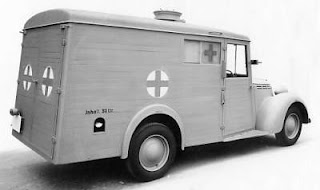Il Renault AHS è un camion leggero francese da 2 tonn. prodotto per l'esercito tedesco dal 1941 al 1944.
Questa variante fu molto utilizzata nel settore sud-orientale dell'Europa: Jugoslavia, Italia, Grecia.
Il modello:
Il modello è stampato in resina in maniera eccellente, i pezzi sono limitati ed è facile rimuovere gli estrattori.
Ho confrontato i pezzi ed il modello a montaggio finito e la somiglianza con il veicolo reale è notevole; non sono abituato a contare i rivetti o misurare ogni pezzo, mi accontento che alla fine il modello sia molto simile al veicolo reale: l'effetto scala non si può eliminare, specie in pezzi così piccoli.
Le uniche aggiunte apportate al modello sono i due tergicristalli e lo specchietto laterale, realizzati in filo di rame e plastica per maggiore solidità.
La colorazione:
Dopo aver lavato il modello in acqua e sapone e dopo averlo spruzzato con Primer Citadel Nero, il modello è stato colorato e invecchiato con la mia consueta tecnica,totalmente in giallo sabbia.
Qui puoi trovare la descrizione della tecnica :
Con bianco acrilico, diluito con acqua in varie proporzioni, ho poi provveduto a simulare una mimetica invernale campale, dipinta a pennello: un pennello 10/0 ha facilitato il lavoro.
Per realizzare la mimetica ho consultato alcune foto di mezzi reali trovate su Internet.
Il fango è stato realizzato con la pasta "terreno pronto"
Qui trovi il link per poterla realizzare:
Il carico:
Il carico è composto da pezzi di legno, che ho realizzato con uno stuzzicadenti tagliato in due e sezionato in vari pezzetti; ho colorato la parte esterna (corteccia) in marrone scuro, mentre per la parte interna ho semplicemente dato un leggero lavaggio di marrone chiarissimo ad olio.
I sacchi e i teli sono realizzati con stucco bicomponente Tamiya.
Renault AHS, Alby 1/72
Renault AHS is a light French truck (2 ton. load) built for German Army in 1941-1944.
This version is often utilised in south-east of Europe theather: Jugoslavia, Italy, Greece.
The model:
The kit is superbly casted in resin, not a great number of pieces.
Resin sprues are easily removable.
I check the pieces and the built model with historic images and is very similar to the real vehicle.
I dont like so much to measure every piece and to count rivets: the scale effect is nearly impossible to bypass in these little models.
Side mirrors and windshield wiper are realized in brass wire and plastic for give more resistance to the pieces.
The paint:
After a wash with water and soap, I spray the model with Citadel Black primer.
The painting process is the same for all my models, you can find the guide here:
In this case, the Renault is entirely painted and weathered in
German sand yellow.
With a diluted acrylic white paint I start to draw the whitewashed, brush-made camouflage:
A 10/0 brush is very useful.
I suggest to search in Internet some historic photos to have a good result.
The mud is realized with the "ready terrain paste"; here you can find the guide to make it:
The load:
The truck load is made with cutted toothpicks: they are cut in half and reduced in little pieces.
The exterior (Bark) is painted with a very dark brown, the interior is only washed with a very diluted light oil sand brown.
The coal bag and tarpaulin are made with Tamiya epoxy putty.
Il fango realizzato con la "pasta terreno pronto" / the mud, realized with "ready terrain paste".
Il carico / the truck load
Ciao Simone


































